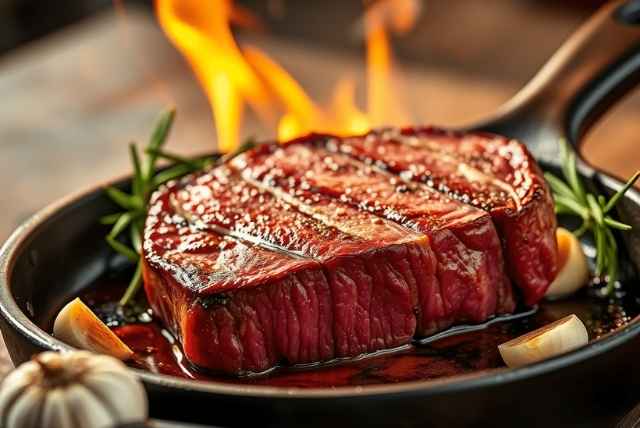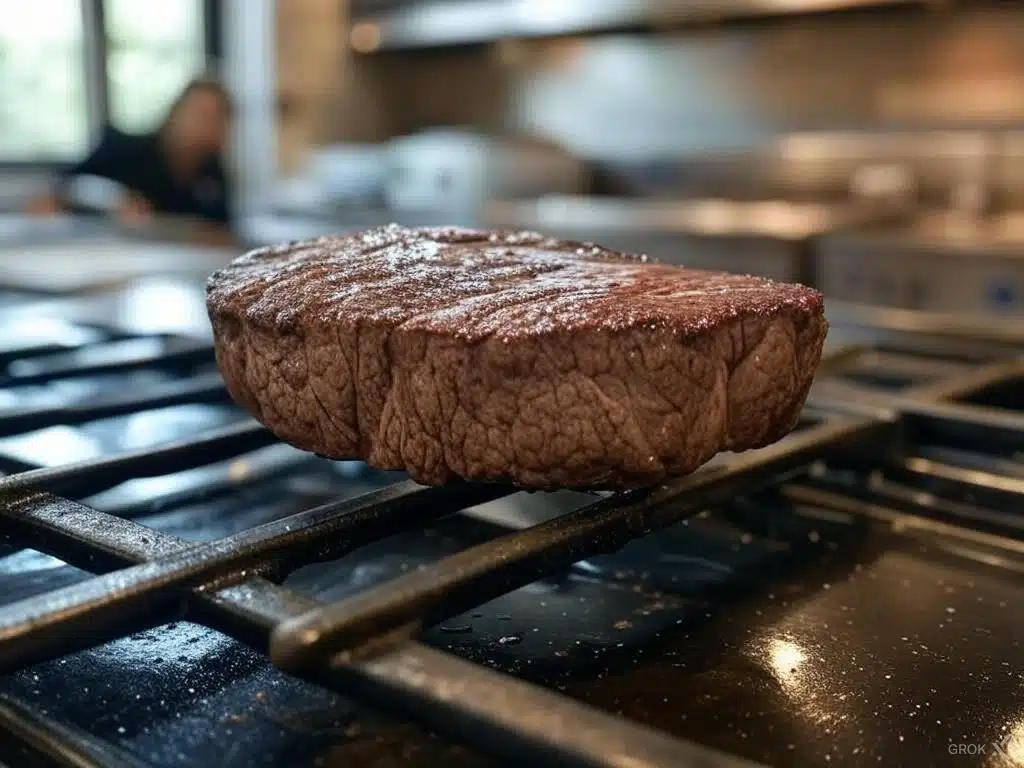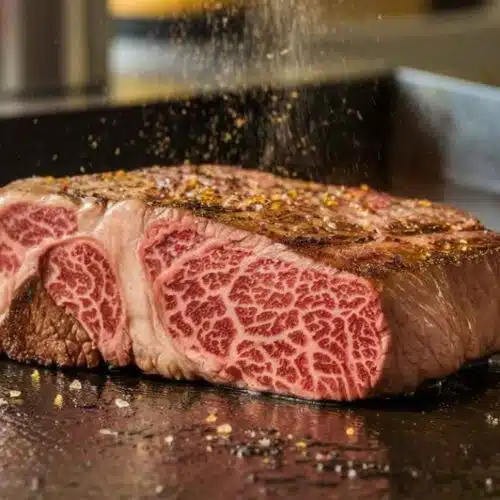Wagyu Tenderloin Recipe

Last updated on September 1st, 2025 at 03:42 pm
If you enjoy beef, you’ve likely heard of Wagyu. It’s known for being almost mythical in both quality and flavor. But cooking Wagyu tenderloin? Well, that takes this whole experience to another level. Wagyu is like the rockstar of beef from Japan.
It’s got these cool fat lines that make it super tasty and soft.
Now, when we talk tenderloin, we refer to the part of the cow that is extremely tender.
You could almost eat it with a spoon. But don’t do that; we’ve got forks for a reason!
So what’s the deal with Wagyu anyway?
Well, it originally came from Japan and has become famous worldwide for good reason. It’s not just a steak – it’s like edible art.
Wagyu is special because of the way the fat blends with the meat. It looks like delicate white lines running through the red. It’s pretty cool to look at, actually.

The farmers who raise Wagyu cattle take their job really seriously.
They’ve been perfecting their methods for generations, and it shows in the quality of the meat.
The first time I tried it, I was blown away by how buttery and rich it was. Trust me, this isn’t your average steak night dinner.
Picking Out the Perfect Cut
When you’re at the butcher shop looking for Wagyu tenderloin, look for meat with a deep red color.
Pay attention to the white lines running through it. The more marbling you see, the better it’ll taste.
The Ingredients
- Wagyu Tenderloin: Aim for about 1.5 to 2 pounds for a nice dinner for two.
- Salt: Kosher salt is my go-to for seasoning.
- Black Pepper: Freshly ground, please. It makes all the difference.
- Butter: Unsalted, high-quality butter for a rich finish.
- Garlic: A couple of cloves, smashed, like you’re angry at them.
- Thyme or Rosemary: Fresh sprigs for that aromatic touch but don’t tell them they’re competing.
- Olive Oil: Just a touch for searing.
Select your choice of oil wisely: Choose oils with a high smoke point.
Think of grapeseed or olive oil. This choice withstands the high heat necessary to sear.
Preparing Your Wagyu Tenderloin for Cooking
Here’s a pro tip: let your Wagyu sit out for about half an hour before you cook it.
This helps it cook more evenly. Just remember to pat it dry with a paper towel first.
This is to remove excess moisture, ensuring a perfect sear.
When it comes to seasoning, less is more. A little salt and pepper is all you need.
You want to let the flavor of the meat shine through.
I like to cook mine in a cast-iron skillet. It gives the outside a nice crust while keeping the inside tender and juicy.
Step-by-Step
Preparation: Start by letting your Wagyu sit at room temperature for about an hour.
While it’s warming up, season it generously with salt and pepper.
Searing: Heat your pan – and I mean get it hot. A cast iron skillet is perfect for this.
Add a touch of olive oil. Once it’s shimmering, lay your tenderloin in.
Here’s where the magic happens. You only want to sear it for about 1-2 minutes on each side.
This is necessary if your steak is about 2 inches thick.
We’re looking for a nice crust, not a well-done steak, so don’t overcook it.
Basting: After searing, reduce the heat a bit, then add your butter, garlic, and herbs into the pan.
As the butter melts, start spooning it over the steak. This basting isn’t just for flavor; it also helps to cook the steak evenly.
Keep this up for another minute or so on each side.
Resting: Now, here’s a crucial step many overlook with any steak, but especially with Wagyu.
Remove the steak from the pan and let it rest. I let mine sit for about 5 minutes.
This allows the juices to redistribute, ensuring each slice is as succulent as possible.
Cooking Techniques for Wagyu Tenderloin
When it comes to cooking, there are a few different ways to go.
You can do a reverse sear. This means cooking it slowly at a low temperature first. Then finish it off with a quick sear.
Precision aids stunning results. A low-and-slow approach is the mantra.
It gently coaxes out the tenderloin’s luxurious textures. This method avoids the risk of overcooking.
This should be accompanied by a quick, high-temperature sear.
You can also try sous-vide cooking for super tender results.
This technique involves vacuum-sealing the Wagyu tenderloin and immersing it in a temperature-controlled water bath.
Grilling is great too. Watch it carefully. Use a meat thermometer to get it just right.
Grilling Wagyu Tenderloin: Tips and Tricks

First, prepare the grill to ensure even heat distribution across the grates.
Next, bring your Wagyu tenderloin to room temperature. This important step (often overlooked) helps prevent uneven cooking.
While grilling, keep the grill lid open for direct heat cooking and flare-up control.
Grilling Wagyu requires attention to detail, ensuring that each side receives an equal amount of sear time and flavor infusion.
Using a meat thermometer is a key trick. It helps monitor the internal temperature.
This guarantees that you reach the perfect medium-rare finish without guessing.
Oven-Roasting Wagyu Tenderloin
Season generously, letting the tenderloin absorb flavors and depth, creating layers (complementary seasoning options abound) and richness.
Next, preheat your oven to a precise 400 degrees Fahrenheit to ensure an even and robust caramelization.
Searing your tenderloin prior to oven-roasting helps lock in flavorful juices.
It creates a delightful crust and succulent interior.
Gentle heat coaxes out the flavors locked within the tenderloin.
Finally, let the roast rest after it’s done to distribute those juices.
Pairing Ideas
Pairing your Wagyu with the right sides can make the meal even better. I love it with some creamy mashed potatoes or a crisp salad.
Some roasted veggies can add nice color and flavor too.
Whatever you choose, make sure it complements the beef without overshadowing it.
As for sauces, a red wine reduction or a peppercorn sauce can be amazing. Or try a mushroom sauce for something a little different.
Sauces that Compliment Wagyu Tenderloin
A beautifully marbled wagyu tenderloin deserves a sauce that enhances its rich flavor.
The classic choice of a rich red wine reduction includes notes of shallots and thyme.
Alternatively, consider a tangy Béarnaise, with its blend of tarragon and vinegar, to balance the beef.
For those with a taste of touch, a velvety mushroom sauce is ideal. It is rich with umami from sautéed cremini mushrooms.
Common Mistakes to Avoid with Wagyu Tenderloin
- Cooking it too quickly can diminish its flavor. To preserve the tenderness and unique taste of Wagyu tenderloin, patience is essential.
- Conversely, rushing the cooking process can strip away the nuanced flavors.
- Using excessively high temperatures may result in a less tender steak.
- Overseasoning can mask the flavor. Focus on enhancing its richness with a light touch, preferring simple seasoning like sea salt and freshly-ground pepper.
- Additionally, avoid overcrowding the pan which could lower the temperature and negatively affect cooking.
- Instead, ensure Wagyu tenderloin has room to breathe, allowing for even heat distribution and optimal taste.
Exploring Other Cuts of Wagyu Beef
There are other cuts of Wagyu beef worth trying too, like ribeye or short ribs.
Each one has its own unique flavor and texture. It’s fun to explore and find your favorites!
Oh, and in case you were wondering – Wagyu isn’t the same as filet mignon.
Wagyu refers to the breed of cattle, while filet mignon is a specific cut of beef.
Both are delicious in their own way, but Wagyu is known for its incredible marbling and rich flavor.
I hope this helps you understand and appreciate Wagyu tenderloin a little more. It really is something special!
Storing and Reheating Leftover Wagyu Tenderloin
If you’re lucky enough to have leftovers (which doesn’t happen often in my house!), wrap them up tight in plastic wrap and pop them in the fridge.
When you’re ready to eat them, heat them up slowly in a low oven. This keeps the meat from drying out.
For reheating, a slow oven method is ideal. Preheat your oven to 250°F. Allow the meat to slowly come back to temperature.
This helps maintain its juiciness. It avoids the sad fate of dryness that often accompanies reheated beef.
For a stovetop approach, consider a gentle sear on low heat in a skillet with butter.

Wagyu Tenderloin Recipe
Ingredients
- 1.5 – 2 pounds Wagyu Tenderloin: Aim for about 1.5 to 2 pounds for a nice dinner for two.
- Salt: Kosher salt is my go-to for seasoning.
- Black Pepper: Freshly ground please. It makes all the difference.
- Butter: Unsalted high-quality butter for a rich finish.
- Garlic: A couple of cloves smashed, like you’re angry at them.
- Thyme or Rosemary: Fresh sprigs for that aromatic touch but don’t tell them they’re competing.
- Olive Oil: Just a touch for searing.
Instructions
- Preparation: Start by letting your Wagyu sit at room temperature for about an hour. While it’s warming up, season it generously with salt and pepper.
- Searing: Heat your pan – and I mean get it hot. A cast iron skillet is perfect for this. Add a touch of olive oil. Once it’s shimmering, lay your tenderloin in. Here’s where the magic happens. You only want to sear it for about 1-2 minutes on each side. This is necessary if your steak is about 2 inches thick. We’re looking for a nice crust, not a well-done steak, so don’t overcook it.
- Basting: After searing, reduce the heat a bit, then add your butter, garlic, and herbs into the pan. As the butter melts, start spooning it over the steak. This basting isn’t just for flavor; it also helps to cook the steak evenly. Keep this up for another minute or so on each side.
- Resting: Now, here’s a crucial step many overlook with any steak, but especially with Wagyu. Remove the steak from the pan and let it rest. I let mine sit for about 5 minutes.